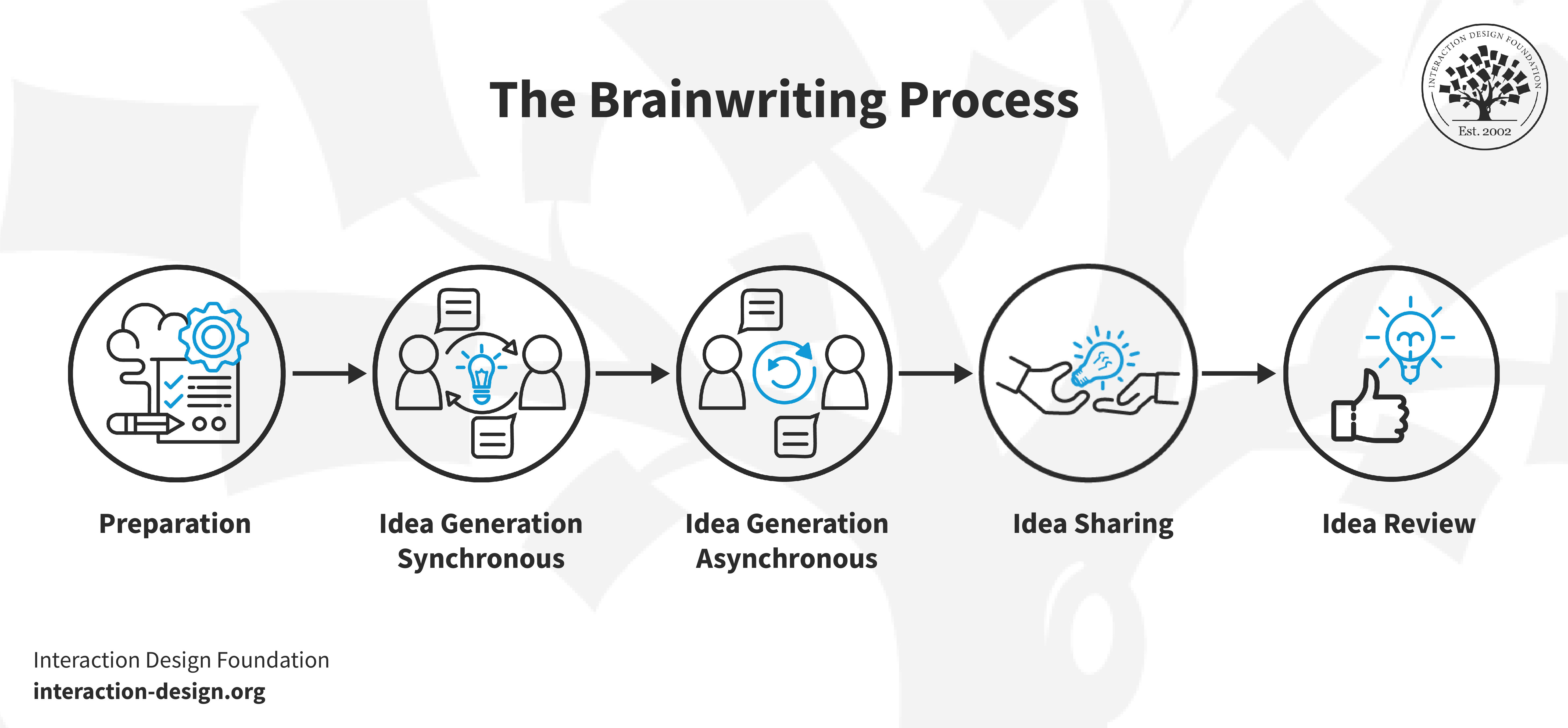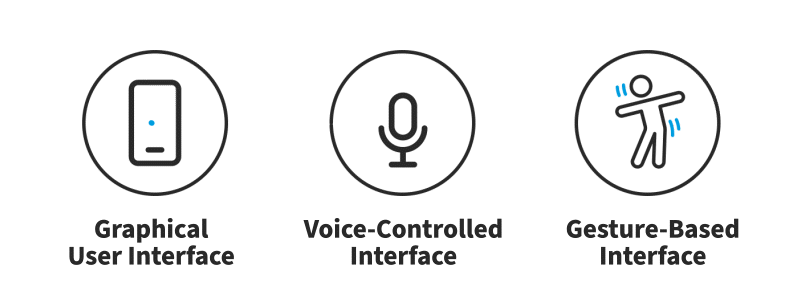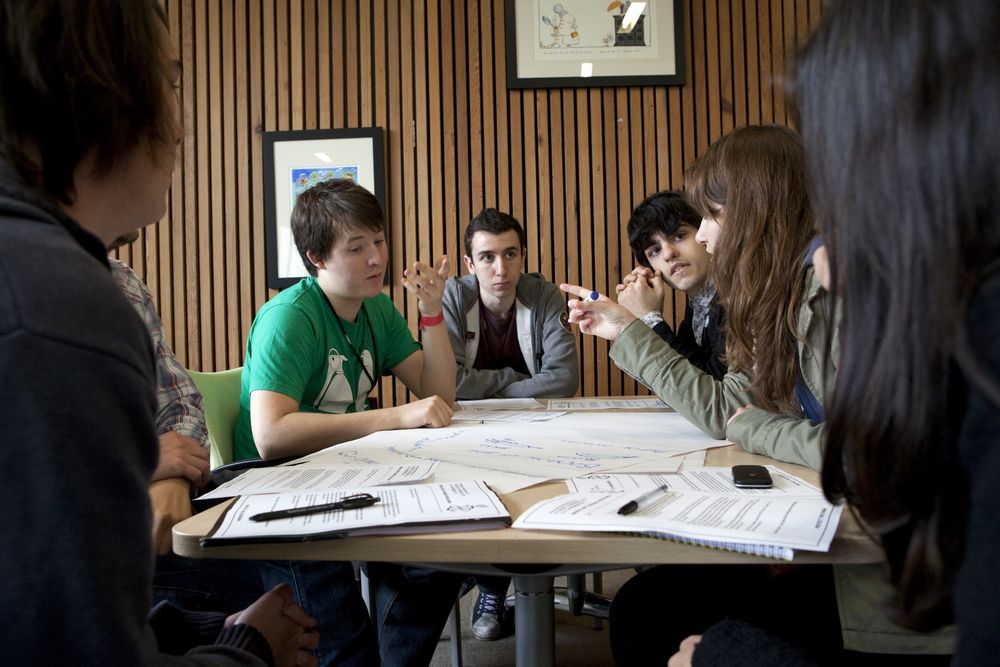Stage 3 in the Design Thinking Process: Ideate

- 1.3k shares
- 6 years ago
Cheatstorming is an ideation technique that primarily uses existing ideas from previous brainstorming sessions as input, rather than new ones. Unlike other ideation methods that discard most generated ideas, cheatstorming practices cognitive sustainability through reuse—to not waste previously ideated material.
Brainstorming and cheatstorming are two techniques used to generate ideas, but they differ significantly in their approach and objectives; however, both help overcome the initial barriers to creativity especially when used together.
Cheatstorming is another ideation method that falls under the umbrella of brainstorming, without starting from zero.
© Interaction Design Foundation, CC BY-SA 4.0
Brainstorming opens the problem space with a breadth of new ideas, while cheatstorming provides a shortcut to innovation by adapting existing ideas to new contexts.
Furthermore, brainstorming is a widely recognized idea generation technique where participants generate a large quantity of ideas in a group setting to encourage a free flow of thoughts and creativity without immediate criticism or judgment. This method operates on the principle that the more ideas generated, the higher the chance of producing a truly innovative solution. Brainstorming emphasizes quantity over quality, with the belief that volume leads to diversity and eventually to the identification of viable and innovative solutions.
Cheatstorming, on the other hand, is a less conventional approach. Designers that use cheatstorming look at existing solutions in similar or different domains and think about how to adapt or “cheat” those solutions to solve their current problem. It's a pragmatic technique that leverages the idea that not all problems require “reinventing the wheel.” Instead, the method borrows and adapts ideas that have proven successful elsewhere to create new, resourceful solutions efficiently and sustainably.
Designers can effectively implement cheatstorming via a structured approach. The fundamental steps for cheatstorming involve:
Access previous brainstorming ideas: Ensure the ideas generated in past brainstorming sessions are easily accessible.
Prepare for a new session: As your team gears up to brainstorm on a fresh topic, select a random assortment of ideas from previous brainstorming sessions.
Identify relevant ideas: Sift through these ideas to find those that align closely with the current topic of discussion.
“...Ideation need not require the generation of new ideas…its value has less to do with the generation of novel ideas than the cultural influence exerted by unconventional ideas on the ideating team…it involves the sharing and interpretation of concepts in unintended and (ideally) unanticipated ways.”
— From Carnegie Mellon’s Abstract on Brainstorm, Chainstorm, Cheatstorm, Tweetstorm: New Ideation Strategies for Distributed HCI Design
Thus, cheatstorming doesn't create new ideas; it cleverly repurposes existing ones to tackle new brainstorming challenges. This method underscores the value of building on what's already been thought of, promoting a culture of sustainability and innovation through adaptation.
For a fresh and productive cheatstorming session, follow these key strategies:
Designers need a clear understanding of the problem or prompt they want to solve. Set specific goals to provide an overview and align all participants. Also, set a time limit to help focus the cheatstorming session. Time constraints support creativity and guarantee the discussion stays on track, leading to productive outcomes.
For a cheatstorming session, assemble a diverse group of participants. Diversity refers not only to professional background and expertise but also to the varying perspectives different cultures, ages and experiences undoubtedly bring.
The greater variety of people, the deeper the pool for new ideas because participants from different walks of life can offer unique solutions that others might not consider. In a company setting, encourage the inclusion of members from various departments, such as design, marketing, engineering and customer experience, to bring a well-rounded view to the problem at hand. This diversity ensures a wide range of ideas and approaches, making the session more productive and dynamic.
Before the session, compile a comprehensive database or repository of ideas and outcomes from previous brainstorming activities or even responses from artificial intelligence (AI) chatbots, for example. This collection can include sketches, notes, mind maps or any form of idea documentation.
During the cheatstorming session, present these ideas to the participants so they have a wealth of resources to draw from. When designers revisit past ideas, participants can reevaluate, combine or expand upon them, leading to apt solutions that may not have been apparent in their original context.
Dive into the pool of existing ideas. Randomly select a sample or choose ideas that seem tangentially related to the current challenge. The randomness can lead to unexpected connections and spark creativity. Encourage the team to look beyond the surface and explore how each selected idea could apply to the problem in new and unconventional ways.
Allow participants to adapt the selected ideas to the new challenge. This step is crucial and requires creativity and open-mindedness. Discuss how these ideas, with modifications, could solve the current design or research problem.
As with any ideation session, keep a detailed record of all ideas and discussions. Pictures like sketches, graphs or charts can help follow the development of ideas and make sure teams don’t forget essential insights.
Critically evaluate the adapted ideas. Consider their feasibility, potential impact and how they address the problem. This step may involve voting on ideas, discussing their merits and drawbacks or further refining them.
Through traditional elements of brainstorming and the strategic incorporation of existing ideas, designers apply a unique approach to innovation during a cheatstorming session. With clear objectives, diverse participants and past brainstorming efforts, designers can create an environment ripe for unexpected connections and novel solutions.
It's essential to approach the session with openness, document every step of the process and critically evaluate the outcomes so the ideas not only are creative but also practical and directly address the defined challenges. While the method is unconventional, it can lead to breakthroughs that might not emerge from standard brainstorming and provide fresh solutions to complex design problems.
Cheatstorming, as demonstrated in Carnegie Mellon's "Study 2" in the academic article “Brainstorm, Chainstorm, Cheatstorm, Tweetstorm: New Ideation Strategies for Distributed HCI Design,” offers a rapid and enjoyable approach to generate creative ideas by repurposing a wide array of existing concepts. The experiment consisted of a cheatstorming session using over 50 ideas from diverse brainstorming sessions and aimed to explore the adaptability and effectiveness of these ideas in various new contexts, such as the creation of intuitive browsing experiences and the design of aesthetically pleasing narrative products and services.
Notecards with possible ideas during the "Study 2" cheatstorming session.
© Brainstorm, Chainstorm, Cheatstorm, Tweetstorm: New Ideation Strategies for Distributed HCI Design. Fair use.
The research revealed that while cheatstorming facilitates quick and creative ideation, it also presents challenges, such as the need for forced connections between ideas and the benefits of implementing time constraints to facilitate quicker and more spontaneous idea selection. Moreover, it highlighted ideas that combine elements from different sources tended to yield the most innovative solutions, despite biases and the reduced excitement over repeated ideas in subsequent iterations.
The study showed the potential of cheatstorming to not only generate solutions relevant to specific prompts but also to capture the original spirit of brainstorming sessions. This suggests that the incorporation of a diverse mix of somewhat related ideas can significantly broaden the scope of ideation for design projects, making cheatstorming a valuable strategy in creative problem-solving.
“The natural reaction of the cheatstormer—indeed, their only real option—is to force an inventive connection between ideation and prompt.”
— From Carnegie Mellon’s Abstract on Brainstorm, Chainstorm, Cheatstorm, Tweetstorm: New Ideation Strategies for Distributed HCI Design
Professor Alan Dix discusses how to think creatively, avoid biases and break out of fixation—just a few limitations that can appear in a cheatstorming session.
While cheatstorming offers a unique approach to leverage previously brainstormed solutions, it comes with challenges designers should consider:
Risk of inhibited creativity: When designers rely too heavily on existing ideas, it can sometimes limit their thinking within established parameters, which can potentially stifle groundbreaking innovation.
Intellectual property concerns: There's a fine line between inspiration and infringement. Cheatstorming requires careful navigation to ensure that new designs do not infringe on existing copyrights, patents or trademarks, which can lead to serious legal complications. The ideation method’s only form of “cheating” should stay within its name.
Hyper-focus on adaptation: Designers who focus on adaptation and improvement of existing ideas or concepts might overlook the opportunity to address problems from an entirely new angle or to innovate in areas where there are no precedents.
Echo chamber effect: Teams that draw inspiration primarily from solutions within a specific domain or industry can lead to an echo chamber—where existing ideas don’t encounter opposition, which could lead to bias. Designs become iterative rather than inventive, and teams potentially miss out on cross-industry innovations.
Quality of source material: The effectiveness of cheatstorming depends on the quality and diversity of the existing solutions analyzed. Poor or limited source material can lead to suboptimal or even biased outcomes.
Groupthink risk: When teams engage in cheatstorming, they risk converging too quickly around a particular idea or solution, especially if it comes from a highly respected source, team member or stakeholder. This can stifle individual creativity and lead to less ingenious results.
Dependency on existing solutions: Though it’s the primary point of cheatstorming, a potential downside is its dependency on existing ideas, designs or solutions. This can limit a designer's ability to think and problem-solve independently from the norm.
Despite these limitations, cheatstorming, when used judiciously and combined with other ideation techniques, is a powerful tool in the designer's toolkit. It's vital for designers to be aware of these challenges and to strive for a balance between using old ideas and inventing new ones.
Learn more about ideation techniques similar to cheatstorming in the IxDF’s courses Creativity: Methods to Design Better Products and Services with Professor Alan Dix and Design Thinking: The Ultimate Guide.
Or, if you’re short on time, unlock your creativity with Professor Alan Dix in the IxDF Master Class, Harness Your Creativity To Design Better Products.
Read Chauncey Wilson’s article Method 24 of 100: Ideation Innovation: New Takes on Brainstorming, which covers the topic of cheatstorming.
Access and read Carnegie Mellon’s full academic entry on Brainstorm, Chainstorm, Cheatstorm, Tweetstorm: New Ideation Strategies for Distributed HCI Design.
Chainstorming is a way for a group to come up with ideas together, where each new idea connects to the one before it, like links in a chain. People take turns to add their ideas and make sure each one relates to or improves the last idea. This method helps everyone think more deeply and creatively because it encourages them to look closely at an idea and find ways to make it better or take it further.
Unlike traditional brainstorming, where designers throw out ideas in a more chaotic and unstructured way, chainstorming ensures a logical flow of thought and the progressive development of solutions. This method is particularly effective when teams need to build upon an initial concept or solve complex problems that benefit from incremental innovation.
You can learn more about traditional brainstorming in the video:
The integration of cheatstorming with other ideation techniques allows teams to approach innovation more thoroughly. They can draw on the strengths of each method to generate, develop and refine ideas more effectively in design processes. Here are some techniques that work well with cheatstorming:
Brainwriting: Brainwriting is an ideation technique in which participants write their ideas in silence instead of speaking aloud. Participants then share their ideas and build upon them. Brainwriting levels the field and encourages introverts and junior team members to participate more equally in ideation sessions. While several variations exist in the brainwriting process, we’ve outlined a general approach above.
While several variations exist in the brainwriting process, we’ve outlined a general approach above.
© Interaction Design Foundation, CC BY-SA 4.0
SCAMPER: SCAMPER stands for Substitute, Combine, Adapt, Modify, Put to another use, Eliminate and Reverse. When designers apply SCAMPER techniques to ideas from a cheatstorming session, it can provide systematic ways to modify and improve existing concepts and encourage deeper exploration of possibilities.
Six Thinking Hats: This method, developed by Edward de Bono, involves examining problems from six distinct perspectives—emotional, informational, logical, creative, overview and caution. Integrating Six Thinking Hats with cheatstorming can help teams explore various perspectives on ideas borrowed from existing solutions. It can also allow for a detailed evaluation and improvement process.
Mind Mapping: Creating visual representations of ideas and their relationships can help teams organize and expand upon the solutions generated during cheatstorming sessions. Mind mapping can help team members see the connections between existing solutions and new contexts or problems.
Storyboarding: Storyboards involve the creation of a visual narrative to explore and present ideas. Teams can use storyboarding to visualize how concepts from a cheatstorming session might unfold in real-world scenarios, which could help identify potential challenges and opportunities for innovation.
Teams can address disagreements or conflicts in a cheatstorming session by adopting strategies that promote constructive dialogue, respect diverse opinions and maintain a focus on the session's goals. Here are practical steps to manage conflicts effectively:
Before beginning the session, agree on ground rules that emphasize respect, open-mindedness and constructive feedback.
Foster an inclusive environment through participation from all team members and give everyone a chance to speak.
Use a facilitator—a neutral referee can help manage the flow of the session, maintain the ground rules and intervene when disagreements arise.
Remind participants of the common goals and objectives of the cheatstorming session, and keep the end goal in sight.
Practice empathy so team members try to understand different points of view rather than immediately counter them.
If disagreements persist, consider break-out groups to explore different aspects of the problem.
When consensus is hard to achieve, vote on ideas to decide which concepts to pursue further.
After the session, allow participants to debrief and reflect on the process—think about how the team handled disagreements.
If conflicts are about technical disagreements or whether the ideas are doable, seek external expertise for an objective viewpoint that helps resolve the issue.
Virtual reality (VR) and augmented reality (AR) can significantly enhance the cheatstorming process in remote or hybrid work environments. These technologies create immersive environments that stimulate collaboration among participants who may not share the same physical space. VR and AR allow team members to interact with three-dimensional models and simulations, making the cheatstorming process more dynamic and engaging. They allow designers and stakeholders to visualize existing ideas and concepts in real-time, leading to deeper understanding and more innovative design resolutions.
Additionally, these immersive technologies can break down communication barriers and provide a sense of presence, making remote participants feel as if they are in the same room, which can lead to more effective and spontaneous solutions.
Don Norman, design expert, discusses the use and power of VR and AR technologies in education, medicine, games and business.
If you want to hear more from Don Norman, then watch his IxDF Master Class, Exclusive: Design for a Better World, a Discussion with Don Norman.
To avoid plagiarism in cheatstorming, designers should take a mindful approach to inspiration and idea generation. They can adhere to the following principles to maintain integrity while using existing concepts:
Always acknowledge sources: Designers should always credit the original source of any idea or design they draw inspiration from. Recognizing the origins of their inspirations is crucial for ethical creativity and invention.
Transform ideas: Use existing ideas as a launch pad for innovation rather than copying them outright. The goal is to add value, modify or combine concepts to produce something new and original.
Focus on learning: Teams should approach cheatstorming as an opportunity to learn from what has worked (or not) in the past. They can analyze the underlying principles of successful designs and consider how to adapt them to new contexts or problems.
Diversify inspiration: Draw from many different sources to inspire true innovation. Look at other industries, cultures and disciplines to help generate unique combinations and interpretations of existing ideas.
Consult legal guidance: When in doubt, especially regarding direct inspiration from copyrighted or patented material, consult legal experts to understand the boundaries of fair use and intellectual property rights.
Promote open communication: Encourage transparency within design teams about where ideas come from and how the team transformed them. This enables an environment of accountability and ethical creativity.
Ethical use of inspiration: Designers must understand that “being inspired by” and “copying” differ significantly. Ethical use of inspiration means designers transform the idea, work or solution and add a unique perspective and value rather than replicating it completely.
Data privacy and collection play a crucial role in the cheatstorming process, especially when teams incorporate ideas from various sources in competitive industries. It ensures that sensitive information remains secure and that all brainstorming activities comply with legal standards and ethical norms. When teams gather and adapt ideas from different origins, they must respect intellectual property rights and protect trade secrets.
Proper data privacy measures prevent unauthorized access and use of proprietary information to maintain trust among collaborators and stakeholders. Additionally, when teams respect data privacy they make room for a safe and respectful environment for innovation, where participants can share and refine ideas without fear of misuse or legal consequences.
Cheatstorming falls under the umbrella of user research, and as with all research in design, transparency is key. Alan Dix provides a summary of managing trust during the research phase in the video below.
 User interfaces are the access points where users interact with designs. They come in three formats highlighted in the GIF.
User interfaces are the access points where users interact with designs. They come in three formats highlighted in the GIF.
© Interaction Design Foundation, CC BY-SA 4.0
Cheatstorming in UI design is not about copying but about imaginative adaptation and enhancement of existing ideas to meet new challenges. It's a strategic approach that respects intellectual property and fosters innovation. It allows UI designers to:
Accelerate the design process: When they start with proven solutions, designers can quickly move beyond common challenges and focus their efforts to customize and innovate ideas for their specific project needs.
Enhance usability: Analyzing and building upon existing UI designs helps guarantee new interfaces are user-friendly. Designers can incorporate best practices and avoid past mistakes. This leads to novel and intuitive interfaces.
Identify trends and patterns: When designers examine existing UI designs, they can identify emerging trends and patterns and position their projects at the forefront of UI innovation.
Reduce risk: Building on existing, successful UI elements can reduce the risk associated with brand-new designs. This strategy can lead to more reliable and user-validated interfaces.
Yes, teams can conduct a cheatstorming session remotely via digital communication tools. Explore some of the critical best practices for remote cheatstorming:
Use collaborative tools: Tools like Google Docs, Miro, Figma or Mural enable participants to contribute simultaneously, view others' ideas and build upon them in real time.
Prepare in advance: Send out materials, such as background information, objectives and any existing solutions for discussion, before the session.
Establish clear guidelines: Share the session's rules and objectives beforehand. Emphasize the importance of respect, open-mindedness and constructive feedback.
Facilitate actively: An effective facilitator is even more crucial in a remote setting to guide the discussion, allow everyone a chance to contribute and keep the session on track. They can also manage the use of digital tools and troubleshoot technical issues.
Maintain engagement: Keep the session dynamic with interactive visual aids, webcams for a more personal connection and short breaks to prevent meeting fatigue.
Record ideas visually: Use the digital whiteboard or shared documents to map ideas and connections visually.
Follow up and get feedback: After the session, summarize the session and record the next steps. Send this summary to all participants for cross-team alignment and to maintain momentum. Ask participants for feedback on the remote cheatstorm to identify the pros and cons for future sessions.
Ensure accessibility: Make sure all participants have access to and are comfortable with the technology. Provide training or guidance if necessary for inclusivity.
Cheatstorming in product design development fosters an environment where the past informs present innovation and focuses on the creation of future solutions that are relevant, practical and groundbreaking. Cheatstorming can influence the product design process in the following ways:
Speeds up ideation: Cheatstorming allows designers to bypass the initial blank-slate phase of product development since they begin with proven concepts. This accelerates the brainstorming process, as designers have a concrete starting point to evolve new solutions.
Improves problem-solving: Designers can quickly identify what works well and what doesn’t when they analyze previous ideas. This gives them space to solve specific problems or fill gaps in the market more effectively.
Facilitates knowledge sharing: Cheatstorming promotes sharing knowledge and experiences among team members and even across industries. Designers learn from past designs to create new solutions and avoid repeating mistakes.
Encourages market awareness: Designers become more aware of the competitive landscape when they examine existing products. This awareness can lead to the development of products that meet user needs and stand out in the marketplace.
Applies existing technologies: Teams can create advanced products without starting from scratch using existing technologies and platforms. This approach helps save time and money in the development process.
Promotes sustainability: Cheatstorming can be thought of as cognitive sustainability in product design and beyond. It encourages the reuse of successful design elements from what has come before. It also reduces waste and the need for new resources.
Learn about sustainability and what it means in brainstorming and design with leading user experience and design expert Don Norman. He helps us understand how to design for a better world, from ideation to the final product.
Remember, the more you learn about design, the more you make yourself valuable.
Improve your UX / UI Design skills and grow your career! Join IxDF now!
You earned your gift with a perfect score! Let us send it to you.
We've emailed your gift to name@email.com.
Improve your UX / UI Design skills and grow your career! Join IxDF now!
Here's the entire UX literature on Cheatstorming by the Interaction Design Foundation, collated in one place:
Take a deep dive into Cheatstorming with our course Creativity: Methods to Design Better Products and Services .
Master complex skills effortlessly with proven best practices and toolkits directly from the world's top design experts. Meet your experts for this course:
Alan Dix: Author of the bestselling book “Human-Computer Interaction” and Director of the Computational Foundry at Swansea University.
Don Norman: Father of User Experience (UX) Design, author of the legendary book “The Design of Everyday Things,” and co-founder of the Nielsen Norman Group.






We believe in Open Access and the democratization of knowledge. Unfortunately, world-class educational materials such as this page are normally hidden behind paywalls or in expensive textbooks.
If you want this to change, , link to us, or join us to help us democratize design knowledge!
